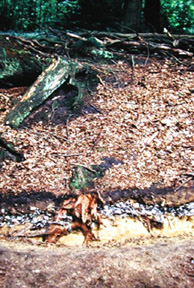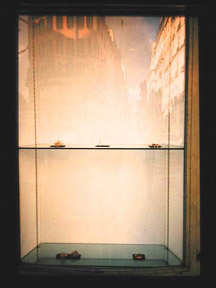 |
|||||||||
|
|
|||||||||
|
|
MICHAEL ROSS January 24 - March 9, 2002 |
 |
 |
|
|
Since the early 1980's, Ross has been one of the few contemporary artists to work exclusively at such tiny dimensions (some of his more long-winded titles take up more space that his sculptures). Small enough to suggest the scale of magazine reproductions, Ross' symmetrically-composed assemblages are not miniatures, but "actual size" artworks. Most have an architectural dimension: screwed into the wall, they literally burrow into a site. Ross' elegant, self-effacing works indirectly raise the question of the relationship between scale and presence - relative values that can only be intuitively felt, rather than objectively measured. Ross' work takes on the model's capacity to effectively suggest far larger sizes, mischeviously confusing one's sense of its physical presence. excerpt from "Homeopathic Strategies" by Ralph Rugoff catalog essay for "At the Threshold of the Visible" exhibition 1997/1999
They call him the pioneer of the subversive small gesture. Michael Ross is one of those artists who have decided to leave the so-called "well trodden path", to focus on domains of research and aspects of reality which are unconventional or often neglected. He belongs to that specific category of artists whose work is characterized by a peculiar intensity, an overwhelming forcefulness which does not express itself in monumental scale or enormous dimensions. What fascinates me in the work of Michael Ross, apart from its smallness of scale and its precision in his attention for detail, is the way in which he creates a microscopic view on things and objects surrounding him. He looks for "minimalist" realities and develops his work according to these lines. The atom, the molecule, the chip; those are the elements which deserve his attention. His work is both poetic and ironic, it is "serious", and yet it has a meditative quality. The intensity of his art might be compared to the sharpness of a needle, despite the very small surface, it has a poignant impact. It pricks you when you least expect it and that's just what the viewer needs. "Micromania" Jan Hoet, Herford 2001 Light's role has been of major importance in the case of Michael Ross' sculptures from the very beginning; in 1991 a perfectly shiny thimble was employed. Later works were always partly realized with recuperated metallic elements, then papers and plastics with luminescent qualities were added or substituted, including sheets of mylar paper, aluminum foils, and safety reflective materials. For the artist, this choice of metallised materials responds to a specific conception of the history of sculpture in which he wishes to inscribe his work. It is a tradition that seems to imply the usage of hard, cold and reflecting metal; what is sculpture without bronze? So his largest work has been produced this year by means of thousands of stainless steel spoons, in Sonsbeek Park in Arnheim. Entangled with one another in a bank of earth, these spoons figured a curious root several meters long, which above all in the evening violently responded to the rays of a setting sun. The proposition constituted a doubting and insistent questioning of the opposition of the categories natural and cultural. Additionally, plastic, foam and cords of all kinds have erupted in his work, introducing vivid colors that from a good distance produce rather pictorial stains that seem to variously modulate the walls' surface. Despite their small size, Michael Ross' works have all the arguments necessary to capture our floating attention, and to attract us toward them in the immense stretch of wall where they seem minute Radeau de la méduse, lost in an infinite ocean of creation. excerpt from "Object a exists, I have met it!" by Emmanuel Latreille 2001 Director, FRAC Bourgogne, Dijon |
||||